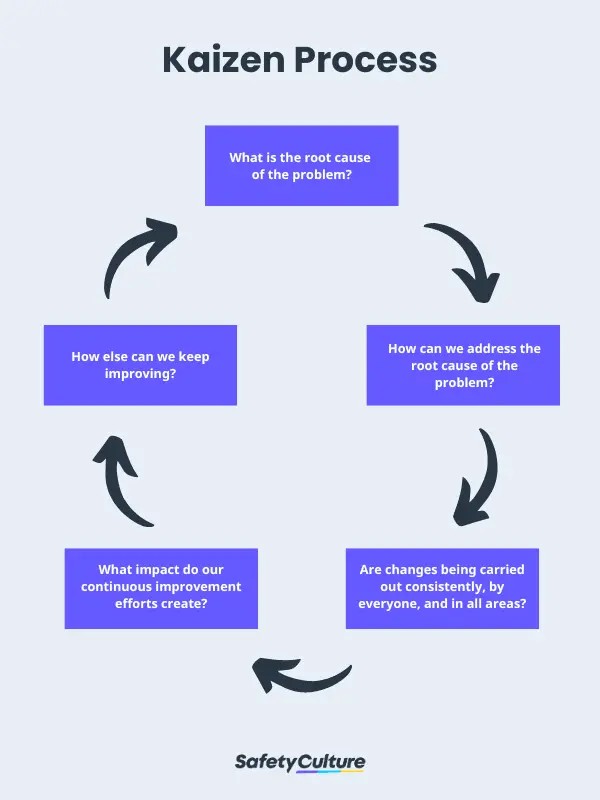What is Kaizen?
Kaizen is a Japanese term meaning “good change”, “change for the better”, or “improvement.” As a business philosophy, kaizen involves all employees and promotes a mindset where small incremental changes create a significant impact over time. As a methodology, kaizen enhances specific areas in a company by involving top management and rank-and-file employees to initiate everyday changes, knowing that many tiny improvements can yield big results.
History and Development
Kaizen’s roots can be traced back to post-World War II, when economic reform consequently took over Japan. Since the Toyota Motor Corporation implemented the Creative Idea Suggestion System in May 1951, changes and innovations led to higher product quality and worker productivity, substantially contributing to the company’s development.
In September 1955, Japanese executives officially started visiting the United States as one of the initiatives of the Japan Productivity Center. Integrating the American way of doing business with a humanized approach eventually pushed Japanese companies into worldwide competitiveness. During the 1980’s, management consultant Masaaki Imai worked with Taiichi Ohno to spread the message of the Toyota Production System (TPS), a result of several years of continuous improvements.
Considered as the Father of Kaizen, Masaaki Imai globally introduced kaizen as a systematic management methodology in Kaizen: The Key to Japan’s Competitive Success (1986). Today, organizations across different industries adopt kaizen as a part of their core values and practice continuous improvement on a day-to-day basis with concepts from six sigma and lean. It is also used with other analytical frameworks such as SWOT.
“Kaizen is everyday improvement—every day is a challenge to find a better way of doing things. It needs tremendous self-discipline and commitment.”
– Masaaki Imai, Founder of Kaizen Institute
Key Elements and Core Principles
Implementing kaizen in the workplace can be near impossible because management usually expects immediate results. Companies often miss out on improved work procedures and optimized business processes which yield a corporate advantage due to focusing too much on results. To maximize the benefits of kaizen, the following elements and principles should be clearly understood before applying them in your context.
Management Commitment
One of the most common reasons kaizen implementation fails is the lack of support and, more importantly, action from leaders. Imai states, “The top management of the company has the most important role in implementing this kaizen approach, and then every manager, then it goes down to rank-and-file employees.” When top management demonstrates its long-term commitment to continuous improvement, managers inevitably follow through on kaizen initiatives and workers personally develop a kaizen mindset.
Employee Empowerment
The employee doing the job would know the best ways to improve how a job is done. Leaders should create an environment where people feel empowered to contribute so that suggestions for improvement can come from all levels and ranks. Encouraging workers to keep adding value to the organization not only boosts morale, it also gives everyone ownership of continuous improvement efforts, which contributes to the successful implementation of kaizen.
Gemba Walk
Achieving operational efficiency begins where the actual task happens, not from a conference room. A Gemba Walk—derived from the term gemba or gembutsu, which means “the real place”—is usually performed by managers to learn or review exactly how a specific process works and gain insights from workers about its improvement. Gemba Walk Checklists guide the observers in asking relevant questions to determine the root cause of problems and the next steps.
5S
One of the biggest barriers to continuous improvement is clinging to old practices or assuming new methods will fail. The 5S principles aim to enhance workplace efficiency by constantly looking for ways to eliminate waste. Organizations should refrain from thinking that just because something worked before means it will continue to work. The 6S of lean added safety to 5S, emphasizing the setup of preventive controls for safe work operations.
“Progress cannot be generated when we are satisfied with existing situations.”
– Taiichi Ohno, Father of the TPS—the basis of lean manufacturing
A Quick and Practical Guide to the Process
Since kaizen is a step-by-step process, the journey of effectively implementing it can only move forward by asking the right questions. Learning the key elements and core principles of kaizen sets up the organization for success because it lays the foundation of how results should be expected. Here are key guide questions to help you get started (and keep going) with continuous improvement initiatives in the workplace:
- What is the root cause of the problem? If an ongoing change-resistant culture is bad, then investing resources in solving the wrong problem is worse. Leaders should deny their assumptions about what (or who) they think is wrong and dig deeper into the issue by practicing Gemba walk and root-cause analysis. Place yourself in a better position to identify quality gaps by personally communicating with employees and observing their work first-hand. Remember not to criticize, find faults, and blame people; instead, generously absorb everything that is currently happening because it is a more accurate reality of a typical day in operations.
- How can we address the root cause of the problem? One of the simplest problem-solving techniques is the 5 Whys Analysis, and performing it to determine the root cause of a problem can be effective in formulating solutions that prevent recurrence. Armed with creative suggestions from workers and supported by valuable information from where the work happens, managers can now implement low-cost but high-value improvements which align with the quality objectives of the organization.
- Are changes being carried out consistently, by everyone, and in all areas? The management displays its commitment to continuous improvement when it immediately takes action on the small incremental changes and follows through with impactful long-term initiatives. Walk the talk by personally changing the way you work and taking note of its effects on the quality of your output. Kaizen is for everybody—meaning it can be used not just by team members but also by leaders —and should take place everywhere, not just on the shop floor. Save time and money from manual monitoring across different sites and all levels of the company by centralizing kaizen management.
- What impact do our continuous improvement efforts create? Individuals tend to give up on implementing kaizen because they do not instantly see or feel the difference their seemingly small actions make in the whole company. The A3 report or 8D report are ideal documents to share with employees because it monitors the performance and measures the effectiveness of implemented changes and is proven to effectively communicate the impact of kaizen initiatives. As a general rule, continuous improvement done right leads to positive, lasting results that significantly add value to the entire organization. Keep the most impactful solutions in mind to know which actions the company needs to stop, start, and continue.
- How else can we keep improving?The road of continuous improvement is not marked by an attitude of perfectionism but a desire for growth—personal and organizational. Achieving 50% of improvement goals now is good; celebrate the win but never stop improving. Be proactive about solving problems in the workplace because kaizen is an unending process. The kaizen cycle aims to keep on producing industry-shaping innovations through years of continuous improvements.
“There is nothing that can’t be done. If you can’t make something, it’s because you haven’t tried hard enough.”
– Sakichi Toyoda, Inventor of the world’s first non-stop shuttle change automatic loom
A Starting Point for Continuous Improvement
A kaizen blitz, or kaizen event, is a short-term improvement project designed to accomplish significant results in process management and quality issues. Kaizen events focus on improving a specific area of the company, meaning they are ideal to deploy in a business process or department of 50 or fewer employees.
As a short-term approach with visible benefits within weeks, a kaizen blitz enables project management teams to easily obtain a high level of commitment from the people involved and maintain the interest of top management. Conducting a 5-day kaizen blitz can set organizations in motion to intentionally build a culture of continuous improvement or kaizen, but it should not replace implementing the kaizen cycle.
5-Day Example:
Before the event
- Gain the actionable support of any sponsor from top management
- Present the project scope, SMART objectives, and resources needed
- Form a cross-functional blitz team
- Collect the necessary data for defining the improvements required
- Brief the blitz team and other key stakeholders
During the event
- Day 1: Kaizen blitz introduction from top management, blitz team training on process improvement, and project review with a high-level map of the blitz process
- Day 2: Gemba walk with a process map and problem-solving with supporting data
- Day 3: Data analysis and development of workable solutions like 5S
- Day 4: Solutions refinement, prioritization, and implementation
- Day 5: Continuous improvement preparations and planning and presentation of outcomes and recommendations to top management
After the event
- Keep implementing improvements, especially for actions overlooked during the blitz
- Communicate process changes to key stakeholders and all employees
- Sign off on the impact of kaizen blitz (vs. project objectives) with top management
“Long-term commitment to new learning and new philosophy is required of any management that seeks transformation. The timid and the fainthearted, and the people that expect quick results, are doomed to disappointment.”
– W. Edwards Deming, Author of Out of the Crisis (1986)
Create your own Kaizen checklist
Build from scratch or explore free, ready-to-download, and customizable templates.
Browse Kaizen checklistsManagement Success Stories
It takes a long-term commitment of consistently doing incremental changes in daily operations to maximize the benefits of kaizen and create a standard quality of work. Improved quality, productivity, and safety through kaizen management in the workplace results in increased employee morale, customer satisfaction, and company revenue. Taking advantage of smart technology can help organizations easily manage day-to-day continuous improvement efforts and consistently solve problems with cost-efficient solutions.
Examples:
- Toyota Motor Manufacturing (U.K.)
Low-cost creative innovations such as Dougal, reducing wasteful movement by making parts move with the workers, and speeding up tedious tasks by using simple tools (like a sticker picker) save a total of 35.1 seconds per car—conserving almost 10 years of work when applied globally in 2018. Undoubtedly, kaizen elevated Toyota as the world’s first company to produce more than 10 million cars in a year. - TOTO, Ltd.
The Japanese manufacturer of plumbing fixtures also benefited from the kaizen approach to improving quality, with their signature Washlet selling over 50 million units worldwide. In Sunaqua TOTO Ltd., kaizen helps provide a comfortable work environment for people with disabilities. Kaizen led them to redesign trash receptacles for easier transportation and rearranging supplies for easier handling.
Toshiyuki Masatsugu thought of stabilizing hanging screwdrivers with flexible cords, eliminating additional 3.33 man-hours per month. For a company of 100 employees on minimum wage, his practice of kaizen saved as much as ¥13,385,476.125 ($124,337.94) every year. According to Masatsugu, “It really feels like you’ve accomplished something when you come up with a new technique like this. We all enjoy thinking and working together to make our job better.” - Organizational Intervention Studies
Mail delivery workers of the Danish Postal Service have limited influence on how tasks are accomplished and decisions about the work environment are made. Results show that implementing kaizen for a number of years helped them increase the level of awareness and capacity to manage issues, which led to increased job satisfaction and mental health.
Kaizen in a Swedish regional hospital predicted better integration of organizational and employee objectives after 12 months. The findings suggest that participatory and structured problem-solving approaches that are visual and familiar to people can facilitate organizational interventions.
Continuous Improvement in Your Workplace
Embracing kaizen as a way of improving work quality sets up the organization for operational excellence. Since small incremental improvements yield big results over time, begin (or continue) your kaizen journey today with these kaizen rules in mind. Let Toyota’s Founder encourage you: “Before you say you can’t do something, try it.”




